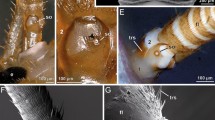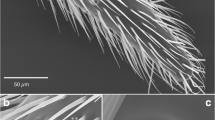Abstract
Caterpillars of Utetheisa ornatrix are monophagous on species of Crotalaria from which they obtain pyrrolizidine alkaloids (PAs) for defense and which the males convert to a pheromone. We show that a taste receptor neuron in each of the lateral and medial galeal styloconic sensilla responds to PAs of three different types. Monocrotaline, commonly present in Crotalaria species, is the most strongly stimulating with thresholds of response below 10−11 and 10−9 M in the two sensilla. These are among the lowest known taste thresholds in any insect and are similar to the thresholds for PAs in a polyphagous arctiid caterpillar that also sequesters PAs and uses them as the source of male pheromone. The receptors also respond to heliotrine, a type of PA that is probably never encountered by the insects. Monocrotaline and senecionine N-oxide are shown in behavioral assays to be phagostimulants. The data show that there is no tight link between taste receptor sensitivity to specific PAs and hostplant selection in these caterpillars. Perhaps the adults are primarily responsible for hostplant selection.
Similar content being viewed by others
References
Bernays, E. A. and Chapman, R. F. 2001. Taste cell responses in the polyphagous arctiid, Grammia geneura: Towards a general pattern for caterpillars. J. Insect Physiol. 47:1029–1043.
Bernays, E. A., Chapman, R. F., and Hartmann, T. 2002a. A highly sensitive taste receptor cell for pyrrolizidine alkaloids in the lateral galeal sensillum of a polyphagous caterpillar, Estigmene acraea. J. Comp. Physiol. A 188:715–723.
Bernays, E. A., Chapman, R. F., and Hartmann, T. 2002b. A taste receptor neurone dedicated to the perception of pyrrolizidine alkaloids in the medial galeal sensillum of two polyphagous arctiid caterpillars. Physiol. Entomol. 27:312–321.
Bogner, F. and Boppré, M. 1989. Single cell recordings reveal hydroxydanaidal as the volatile compound attracting insects to pyrrolizidine alkaloids. Entomol. Exp. Appl. 50:171–184.
Bogner, F. and Eisner, T. 1991. Chemical basis of egg cannibalism in a caterpillar (Utetheisa ornatrk). J. Chem. Ecol. 17:2063–2075.
Bogner, F. and Eisner, T. 1992. Chemical basis of pupal cannibalism in a caterpillar (Utetheisa ornatrrk). Experientia 48:97–102.
Bogner, F., Grant, A. J., and O'Connell, R. J., 1992. A potential kairomone stimulates pheromone-responsive pheromone neurons in Utetheisa ornatrix (Lepidoptera: Arctiidae). J. Chem. Ecol. 18:427–439.
Conner, W. E., Eisner, T., Vander Meer, R. K., Guerrero, A., and Meinwald, J. 1981. Precopulatory sexual interactions in an arctiid moth (Utetheisa ornatrix): Role of a pheromone derived from dietary alkaloids. Behav. Ecol. Sociobiol. 9:227–235.
Conner, W. E., Roach, B., Benedict, E., Meinwald, J., and Eisner, T. 1990. Courtship pheromone production and body size as correlates of larval diet in males of the arctiid moth, Utetheisa ornatrix. J. Chem. Ecol. 16:543–552.
Craig, C. F. and Purushothaman, K. K. 1970. An improved preparation of tertiary amine-N-oxides. J. Org. Chem. 35:1721–1722.
Dussourd, D. E., Harvis, C. A., Meinwald, J., and Eisner, T. 1991. PheromonaI advertisement of a nuptial gift by a male moth (Utetheisa ornatrix). Proc. Natl. Acad. Sci. USA 88:19224–9227.
Dussourd, D. E., Ubik, K., Harvis, C., Resch, J., Meinwald, J., and Eisner, T. 1988. Biparental endowment of eggs with acquired plant alkaloid in the moth Utetheisa ornatrix. Proc. Natl. Acad. Sci. USA 85:5992–5996.
Eisner, T. and Eisner, M. 1991. Unpalatability of the pyrrolizidine alkaloid-containing moth Utetheisa ornatrix, and its larva, to wolf spiders. Psyche 98:111–118.
Eisner, T., Eisner, M., Rossini, C., Iyengar, V. K., Roach, B. L., Benedikt, E., and Meinwald, J. 2000. Chemical defense against predation in an insect egg. Proc. Natl. Acad. Sci. USA 97:1634–1639.
Frazier, J. L. and Hanson, F. E. 1986. Electrophysiological recording and analysis of insect chemosensory responses, pp. 285–330, in T. A. Miller and J. Miller (Eds.). Insect–Plant Interactions. Springer, Berlin.
Gonzalez A., Rossini, C., Eisner, M., and Eisner, T. 1999. Sexually transmitted chemical defense in a moth Utetheisa ornatrix. Proc. Natl. Acad. Sci. USA 96:5570–5574.
Gothilf, S. and Hanson, F. E. 1994. A technique for electrophysiologically recording from chemosensory organs of intact caterpillars. Entomol. Exp. Appl. 72:305–310.
Grant, A. J., O'Connell, R. J., and Eisner, T. 1989. Pheromone-mediated sexual selection in the moth Utetheisa ornatrix: Olfactory receptor neurons responsive to a male-produced pheromone. J. Insect Behav. 2:371–385.
Hare, J. F. and Eisner, T. 1993. Defense mechanisms of arthropods. 118. Pyrrolizidine alkaloid deters ant predators of Utetheisa ornatrix—Effects of alkaloid concentration, oxidation-state, and prior exposure of ants to alkaloid-laden prey. Oecologia 96:9–18.
Hartmann, T. and Witte, L. 1995. Chemistry, biology and chemoecology of the pyrrolizidine alkaloids, pp. 155–233, in S. W. Pelletier (ed.). Alkaloids: Chemical and Biological Perspectives. Pergamon, Oxford, Vol. 9.
Hartmann, T. and Zimmer, M. 1986. Organ-specific distribution and accumulation of pyrrolizidine alkaloids during the life history of two annual Senecio species. J. Plant Physiol. 122:67–80.
Hodgson, F. S., Lettvin, J. Y., and Roeder, K. D. 1955. Physiology of a primary chemoreceptor unit. Science 122:417–418.
Iyengar, V. K., Rossini, C., and Eisner, T. 2001. Precopulatory assessment of male quality in an arctiid moth (Utetheisa ornatrix): Hydroxydanaidal is the only criterion of choice. Behav. Ecol. Sociobiol. 49:283–288.
Johnson, A. E., Molyneux, R. J., and Merrill, G. B. 1985. Chemistry of toxic range plants. Variation in pyrrolizidine alkaloid content on Senecio, Amsinckia and Crotalaria species. J. Agric. Food Chem. 33:50–55.
Kelley, K. C., Johnson, K. S., and Murray, M. 2002. Temporal modulation of pyrrolizidine alkaloid intake and genetic variation in performance of Utetheisa ornatrti caterpillars. J. Chem. Ecol. 28:669–685.
Noldus, L. P. J. J. 1991. The observer: A software system for collection and analysis of observational data. Behav. Res. Methods Instruments Comput. 23:415–429.
Robinson, G. S., Ackery, P. R., Kitching, I. J., Beccaloni, G. W., and Hernandez, L. M. 2002. Hosts—A database of the hostplants of the world's Lepidoptera. www.nhm.ac.uklentomologv/hostplants/
Schulz, S., Francke, W., Boppre, M., Eisner, T., and Meinwald, J. 1993. Insect pheromone biosynthesis: Stereochemical pathway of hydroxydanaidal production from alkaloidal precursors in Creatonotos transiens (Lepidoptera, Arctiidae). Proc. Natl. Acad. Sci. USA 90:6834–6838.
Silva, K. L. and Trigo, J. R. 2002. Structure activity relationships of pyrrolizidine alkaloids in insect chemical defense against the orb-weaving spider Nephila clavipes. J. Chem. Ecol. 28:657–668.
Smith, J. J. B., Mitchell, B. K., Rolseth, B. M., Whitehead, A. T., and Albert, P. J. 1990. SAPID Tools: Microcomputer programs for analysis of multi-unit nerve recordings. Chem. Senses 15:253–270.
Soldaat, L. L., Boutin, J.-P., and Derridj, S. 1996. Species-specific composition of free amino acids on the leaf surface of four Senecio species. J. Chem. Ecol. 22:1–12.
Weber, S., Eisenrbich, W., Bachbr, A., and Hartmann, T. 1999. Pyrrolizidine alkaloids of the lycopsamine type: Biosynthesis of trachelanthic acid. Phytochemistry 50:1005–1014.
Williams, M. C. and Molyneux, R. J. 1987. Occurrence, concentration and toxicity of pyrrolizidine alkaloids in Crotalaria seeds. Weed Sci. 35:476–481.
Witte, L., Rubiolo, P., Bicchi, C., and Hartmann, T. 1993. Comparative analysis of pyrrolizidine alkaloids from natural sources by gas-chromatography–mass spectrometry. Phytochemistry 32:187–193.
Author information
Authors and Affiliations
Corresponding author
Rights and permissions
About this article
Cite this article
Bernays, E.A., Chapman, R.F., Lamunyon, C.W. et al. Taste Receptors for Pyrrolizidine Alkaloids in a Monophagous Caterpillar. J Chem Ecol 29, 1709–1722 (2003). https://doi.org/10.1023/A:1024239201198
Issue Date:
DOI: https://doi.org/10.1023/A:1024239201198




